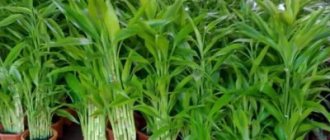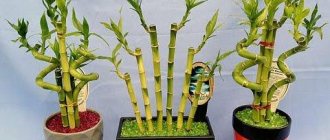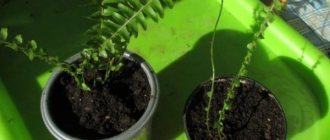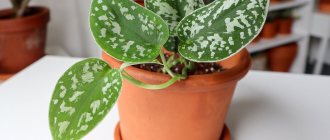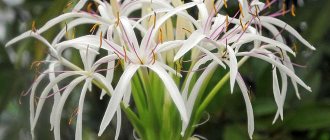An evergreen exotic stem can exist for a long time at home. With proper care, the bamboo indoor plant will bloom with beautiful small flowers. The frequency and size of the color depends on the species. Any of them can be grown in soil or placed in water. You can make it even more decorative if you twist the elastic stems in time by fixing them on a guide object, by limiting the space. Green shoots look good alone and in compositions.
About the plant
Another name for decorative bamboo is Dracaena Sander. In the 19th century, it was brought from China by the English florist Frederick Sander. The plant has a bare stem with lanceolate leaves at the top. The greenery quickly increases in size. After a few months, even dwarf varieties can reach 1 meter in height.
Indoor bamboo is used for decorative purposes. It will fit perfectly into any interior and will be an original decoration for a residential or office space. The ability of the stems to twist in different directions gives designers the opportunity to imagine in any direction, creating original compositions.
Description and characteristics of the plant
Bamboo, which is used in the interior, belongs to the Dracaena family; only its appearance is similar to its wild counterpart.
Features of indoor bamboo:
- the stem is dense, fleshy with knotty isthmuses;
- green oblong leaves at the top;
- a healthy plant is bright green, the leaves are shiny, do not turn yellow or fall off, glossy and hard;
- does not bloom at home;
- grows both in soil and in water;
- feels good in conditions similar to natural ones.
The Chinese believe that bamboo brings happiness and good luck to the home.
Types and varieties
Indoor bamboo is a miniature plant. It is grown at home in pots with soil or special transparent containers covered with pebbles and filled with water. Bamboo care is minimal. The plant requires lighting, watering and periodic feeding. All varieties have a hollow stem in common. Various species are classified by size and are divided into the following groups:
- Low. Plants grow up to 1 meter. Popular varieties are “Golden Lily”, “Tsuboi”;
- Average. Reach 3.5 meters in height. Beautiful varieties - “Shiroshima”, “Mexican weeping”;
- Tall. A rarity for interiors, as they stretch up to 6 meters. Bright representatives of the group, similar to giants, are “Tropical Black”, “Monastic”.
When choosing a variety, you must clearly understand the purpose of planting. It is necessary to take into account the height of the plant and how it will look, the shape of the leaves, and the type of root system. For some species, solitary existence is more suitable, while others feel better in groups.
How to twist a spiral
Intertwined and spiral-twisted bamboo stems are in high demand. Making a plant bend in the right way is difficult and painstaking work. It takes gardeners months of daily labor to shape and curve a bamboo plant beautifully.
How to bend bamboo Source bronx120.org
The formation of the trunk begins after a strong root system has formed. One way is to place the sprout in a curved tube. The gardener monitors the growth by controlling the size of the stem. When the desired form is obtained, the plant is released from captivity.
Regular and molded bamboo Source www.jornalahora.com
The stems always grow towards the sun. This law serves as a key operating element in another common forming method. In Asian countries, growing on its side is practiced. The flower is placed in a box open on one side; it must be rotated relative to the light, observing regularity. Theoretically, this process can be reproduced at home.
Decor for every taste Source 4.bp.blogspot.com
Growing at home with limited access to light is a time-consuming task that can take more than one month. You can grow decorative bamboo at home in a simplified way, using young stems that have not yet hardened. To do this, the plastic stem is fixed on a support of the desired shape using thin wire and tape. When the bamboo stem is completely lignified, the support is carefully removed.
In an eco-interior Source raw.cdn.baca.co.id
Conditions for keeping the plant
It is very easy to create comfortable living conditions for bamboo. Houseplants need good lighting and fresh air. The shoots receive nutrition through the root system, so systematic watering and fertilizing are important. Depending on the type of planting (soil or water), certain care rules apply.
Lighting and location
Indoor bamboo does not tolerate direct sunlight. The place must be chosen to be bright, but with dosed penetration of ultraviolet radiation. Darkening in the midday heat can be achieved with the help of a curtain. In regions with prevailing cloudy weather, during periods of decreasing daylight hours, plants can be artificially illuminated with special lamps. Lack of light affects the appearance of greenery - the foliage falls off, the trunk turns yellow, and growth slows down sharply.
It is better to place a pot of bamboo on a western or eastern window sill. It should not be allowed to overcool, so in winter it is better to move the container to the center of the room and carefully ventilate it.
Air temperature and humidity
As the seasons change, the temperature preferences of indoor bamboo change. Elevated values for it are equally destructive as low ones. To maintain a good humidity regime, the temperature in summer should not exceed 35 °C, in winter – 15 °C. If the room is very hot, the pot with the plant should be temporarily moved to a room without windows (hallway, bathroom). Optimal temperature indicators are 25-30 °C.
Humidity is not very important for plant development. But since dracaena is a tropical plant, too dry air can harm it. You should not use a spray bottle to spray the foliage; oversaturation with liquid will lead to rotting of the stem. If the air is warm and dry, you can place a plate of water next to the bamboo. Regularly wiping the leaves with a damp cloth will do more good than watering on a hot day.
Answers on questions
Is it possible to keep bamboo in an apartment?
Indoor bamboo is specially bred for growing at home. According to Feng Shui philosophy, bamboo attracts good luck and happiness to the house, and grants longevity to the owner. That's why it is called lucky bamboo.
Why does bamboo turn yellow?
The evergreen plant may turn yellow. This may happen due to:
- lack of light;
- exposure to direct sunlight;
- lack of moisture;
- lack of nutrients;
- poor drainage system;
- drafts;
- watering with unfiltered water.
How fast does indoor bamboo grow and what to do if it grows very slowly
The growth rate is incredible; on average, bamboo reaches medium size in 5 years. If the dracaena suddenly stops growing, this indicates watering with hard water and lack of light.
Leaf blades become limp and curled
This is due to hypothermia.
Why do black spots appear on bamboo leaves?
Bamboo is affected by fungus; ventilation must be provided.
Is it possible to prune indoor bamboo?
It is possible and necessary to trim homemade bamboo; this is often done for decorative purposes.
How to root bamboo at home
For rooting, pinch off the top and place in a glass of water until roots appear. When the first shoots appear, the bamboo is planted in a pot with soil.
Choosing a container for planting
The pot must match the size of the bamboo and the number of its stems. The shoots must be at least 5 cm from the edge of the container. It is not necessary to place them strictly in the center. Any flower pot with drainage holes is suitable for planting in the ground. If you decide to grow a plant in ordinary water or hydrogel, it is better to use a beautiful transparent vase. You can hide the root system with the help of beads and pebbles.
The recess of the container should be twice the size of the rhizome. A flat, small flowerpot will not work. Plants planted in water will have to be pruned periodically, since the root system is branched and grows quickly. Each grower chooses the growing method for himself, having previously assessed the pros and cons of each option.
Using bamboo
Bamboo plays not only a decorative role
The plant is used quite widely:
- Young shoots are eaten as a vegetable. How crops are grown in Italy.
- The trunks are used as building materials.
- Bamboo is split and its fiber is used to create wicker items.
- The seeds are similar to oats and are also eaten.
- Used to make canes and umbrella handles.
- They make hats.
- Mats and sushi sticks are made from bamboo.
- The Thais used trunks - straws for water supply.
- Furniture is made from bamboo.
Growing in soil
The option of growing in the ground is more preferable for dracaenas. Water does not linger for long, which prevents root rotting. Any soil mixture for indoor plants, consisting of clay turf, peat, and humus, is suitable. There must be a drainage layer - 5-6 cm of sand, small pebbles. After planting in the ground, the plant is watered and placed in partial shade for several days.
Bamboo grown with a closed root system must be fertilized. In spring and autumn, complex lawn mixtures saturated with nitrogen are used. The first flower transplant is carried out after 2 years. Then only the top layer of soil is replaced. A shallow cut at the bottom of the stem will help stimulate root development.
Each time you replant, you must carefully inspect the bamboo roots. Rotten, old and damaged ones should be removed.
Description
Bamboo, whose height reaches 11 meters, is distinguished by strong branching in its upper part. Bamboo is characterized by rapid growth, up to 0.7 m in height per day and is the fastest growing plant in the world. Spikelets are multi-flowered, arranged in groups and singly on branches with scale-like leaves.
The flowers of the plant are bisexual and wind-pollinated. Ripe grains fall out of the scales and are spread by wind or animals. The above-ground part, after completing its fruiting, completely dies, leaving only the rhizome in a viable state. On average, bamboo in a country house lives for several decades. The duration of the life cycle directly depends on the growing conditions.
Growing bamboo in water
For a long and trouble-free existence of bamboo in a liquid environment, simply placing it in water is not enough. An unpretentious plant will need to create optimal conditions for rapid growth. By doing group plantings, you can create your own tropical garden in a short time. The original method of growing will give the best result - a strong trunk, lush greenery, if planting bamboo in the house is carried out according to the following plan:
- The root system is inspected, overgrown, weak roots are removed. You can safely cut off up to 1/3 of the base;
- Select a container. It should be a low, wide vase. A transparent glass with decorative natural stones looks beautiful;
- The decor and container must be boiled in water before use;
- The bamboo stem is lowered into a vase, the roots are carefully leveled and fixed with decor;
- Fill the plant with filtered, settled water 2 cm above the stones;
- The fluid must be changed at least once every two weeks. The first signs that the water requires replacement are a musty smell, bubbly, cloudiness, and the appearance of foam;
- When watering every month, bamboo is fed with phosphorus, nitrogen fertilizers and their varieties.
Ways to grow indoor bamboo
Growing bamboo in a container with soil
Bamboo feels better in soil than in water. It develops a good root system and you can grow a beautiful plant, the size of which will depend on the development of the roots. The smaller the pot, the shorter the stems will be.
Instructions for growing in soil:
- choose a pot, preferably squat with a large diameter;
- It is better to purchase special soil for growing dracaenas, but you can also mix peat, humus and clay turf yourself;
- ensure good soil drainage;
- once a month the plant needs to be fed;
- the soil should be constantly slightly moist, but not too wet;
- Replantation is recommended every three years.
Growing bamboo in water
Bamboo feels good in water and produces abundant leaves, but this method requires discipline - the water must be changed at least once a week.
Instructions for growing in water:
- prepare the root system, remove damaged roots;
- select a high container, something like a flask;
- filtered water can be used, but settled water will not cause harm;
- Carefully place the plant in a container and cover the roots with decorative stones;
- the water should always be clean, do not let it stagnate and bloom;
- Once a month you need to fertilize the plant.
Growing bamboo in hydrogel
The process is identical to that of growing in water with decorative stones, but somewhat simpler. Instead of stones, the roots are covered with granules and filled with clean water, then all that is necessary is to add water as needed and feed once every six months. It is better to choose a hydrogel with small granules, they will not allow the root system to be exposed.
Advice! In a container with bamboo, you need to maintain a low water level, just so that the roots are covered; if the trunk is in the water, then roots will appear at this distance, which does not look aesthetically pleasing.
How to properly care for a plant
Growing bamboo at home is not easy, despite its love of moisture and rapid growth in favorable conditions. Creating such an environment will require constant attention, the availability of prepared water, and certain skills in floriculture. A unique green perennial will be an excellent decoration for a house or apartment if you provide it with suitable growth conditions - choose the right location, moisten it in a timely manner, prune it, protect it from pests and diseases, and properly care for it.
The soil
You can use any soil for bamboo. A simple mixture of lawn soil and sand will do. But it is better if the soil is acidic, slightly acidic. Heavy soil contributes to root rot and slower growth. Broken shards, expanded clay, and small pieces of brick can serve as drainage. The bottom layer should occupy 25% of the capacity.
The plant is placed in the center of the pot, the roots are lowered onto the drainage. After filling the soil, it should be lightly pressed down to release the air. The soil should always be moist. The top layer is checked by touch daily and loosened once a week.
Watering
It is necessary to moisten the soil only with warm rain, settled water. Regular tap water contains many impurities harmful to plants, which accumulate in the roots and slow down natural processes - photosynthesis worsens, leaves turn pale and become deformed. At such moments, the plant is susceptible to attacks by parasites and loses immunity to many diseases. If it is not possible to collect or filter the liquid, you can soften it by freezing. Water is poured into a plastic bottle and placed in the freezer. After thawing, it becomes suitable for watering.
The frequency of watering bamboo palms depends on the time of year. In spring and summer, moisture should be plentiful, in autumn and winter - moderate. With the arrival of cold weather, the plant can be transferred to independent control of its moisture needs by transplanting it into a vase with water.
It is recommended to water bamboo through a tray. The roots of the plant absorb liquid according to their needs. After a few hours, the water is poured out of the pan. The procedure is repeated when the top layer of soil is completely dry. Do not use a spray bottle or water at the root. Such methods of moistening can lead to the formation of rot on the roots.
Watering should be stopped if the soil begins to emit a putrid odor. If the top layer of soil is covered with a gray or white coating, it must be replaced, the bamboo roots must be washed and disinfected.
Transfer
The hardest and fastest growing grass can be replanted when it has sufficiently developed the root system, up to 4-5 cm. To do this, the cuttings are placed in water and left in a lighted place. Roots that are too long must be shortened to at least 7 cm, otherwise they may get tangled and break at the very base. The transplant procedure is as follows:
- Just before planting, the cuttings are removed from the germination medium, and the still wet roots are treated with a rooting agent;
- Lower the sprout into the hole or onto the drainage, add portions and compact the soil along with the mixture for root growth;
- The soil should reach the top edge of the pot; if it settles during watering, it should be added.
It is better to replant bamboo in early spring, so that the root system has time to strengthen and its leaves do not fall off with the arrival of cold weather. The pot should be deeper and wider than the previous one. During the growth period, the plant should not have its roots in contact with the walls of the container.
Throughout the growing season, bamboo can be replanted several times. The movement is facilitated by rapid growth and the desire to propagate the plant.
Feeding and fertilizers
Indoor bamboo grows much better in a nutrient medium, although it can remain in ordinary water for a long time, content only with its renewal. The main thing when working with fertilizers is not to overdo it. An abundance of nutrients, especially in the first weeks after transplantation, will only cause harm.
All ground types of bamboo are strengthened once a month, starting in spring. In the summer, during the period of active growth, the dosage can be reduced and the time interval between approaches shortened. You can use universal fertilizers specifically designed for palm trees or decorative deciduous perennials.
A herbaceous plant growing in water must be fertilized regularly, even in winter, since such an environment contains much less nutrients than soil. For this purpose, liquid compositions based on nitrogen and phosphorus are used. The recommended dose on the package must be reduced by at least 5 times so as not to provoke rapid growth. You can also use foliar fertilizers instead of root fertilizers, strictly following the spraying rules.
Bamboo trimming
Bamboo can be shaped into any shape. A flexible, unpretentious plant tolerates pruning well with good rooting and in the absence of the slightest disease. First of all, get rid of dry excess stems located at the base of the plant. Then select a branching point, if necessary, connect the shoots with tape, cut off below the marked node. Such herbaceous specimens will no longer grow upward.
For beautiful vertical growth, you need to regularly prune the branches. Thinning is necessary for both straight and spiral varieties of lacbamboo. The cut areas are sprinkled with ash or lubricated with wax. Cuttings are used for rooting. Small cuts in the lower part of the stem will help speed up the process of root emergence.
Instructions for planting in open ground
Bamboo should be planted in the ground as seedlings
So, it will take root faster. Planting should be done in spring or summer. The sooner this is done, the stronger it will become by the winter.
For successful wintering, the roots must be covered for the first year . To prevent young shoots from dying, you need to install protection from the wind. Cold gusts of which will destroy the plant.
Landing
Planting bamboo
Planting is carried out in several stages:
- The lump of earth with roots should be well saturated with water. If this is not done, it will not flow well even with abundant watering. To do this, the pot with the seedling is lowered into a container filled with water. Must be kept in the shade. This procedure will protect the roots from damage when it comes time to pull.
- A hole is dug larger than a coma with roots.
- The soil is fertilized. Humus and humus are added to the pit.
- When choosing running bamboo, a root barrier is installed.
- Place the seedling in the middle of the hole, fill the void with soil and compact it.
- Water the young plant generously.
You cannot fertilize bamboo with fresh manure and chicken droppings. They can burn the roots.
Bamboo running barrier
The roots of running bamboo varieties grow quickly. They spread at a depth of 20 cm, but can come to the surface. A limiter is placed on the site before planting. It is dug to a depth of one and a half meters, with the upper edge protruding 10 cm from the ground.
Barrier device
To limit the spread of the plant you can use:
- Slate
- Metal
- Barrier film
- Root barrier
To prevent the roots from falling through the limiter, you need to dig in at an angle. The top edge of the plant should be located at a greater distance from the trunk. The edges overlap each other.
If the root has bypassed the barrier, you can cut off the unnecessary part. Be sure to pull the piece out of the ground. Otherwise, it will spread further, filling the entire space with young bamboo shoots.
Watering
During the first months after planting, you need to ensure that the soil does not dry out. Water generously. This will speed up the rooting process. But you cannot allow water to stagnate, otherwise the roots will begin to rot.
Bamboo does not tolerate drought
If there is a lack of moisture, the leaves will begin to curl into a tube. The plant quickly dies from drying out. After the bamboo begins to dry, watering is reduced to 3 times a week.
If there is a lack of moisture, as with all cereals, the roots will begin to move deeper. The plant will extract moisture from the depths of the earth. The frequency of watering must be adjusted depending on natural precipitation. In rainy years, watering is reduced.
Mulching
In autumn it is recommended to mulch. Mulch consists of pine bark, wood chips, hay, straw or peat.
Mulching the soil
The layer should be no more than 5 cm . A thick layer may attract rodents, which will damage the bamboo. This layer will ensure stable soil temperature and moisture.
Trimming
The plant is pruned once a year. It should be done in the spring. Remove dry, frozen and unsightly shoots.
Bamboo trimming
If the thickets are dense, thinning is carried out. This procedure will allow the sun's rays to penetrate deeper. Bamboo straws have knots. If you cut above the bud, a new shoot will grow.
Top dressing
Fertilizing is carried out 2 times a year: in spring and autumn. To do this, nitrogen, phosphate and potassium fertilizers are mixed. In spring the ratio should be 4:3:2, in autumn 2:4:4.
When choosing organic fertilizers, they should be applied once a month in spring and summer.
In this case, in autumn and winter, bamboo takes a break from feeding.
Wintering
The upper part of the plant freezes in the first year of growth at -17 degrees, and dies at -20. If weather forecasters predict a cold winter without snow, then young shoots need to be bent and covered. The best shelter is spruce branches.
With each winter the plant becomes stronger and more resistant to frost.
When the trunk and shoots die, the roots are preserved. They are warmer in the ground. There is a chance that they will produce new growth in the spring.
Reproduction
There are 2 ways to grow bamboo:
- From seeds
- Vegetatively
Let's look at them in detail.
Seed propagation
Bamboo seeds
The difficulty of the seed method lies in the rare flowering. The positive side is that bamboo grown this way will be less sick. Its life cycle will be approximately equal to the cycle of the parent plant.
Seed preparation consists of several stages:
- They are dried in the sun for 2 hours
- Soak the planting material in water for 10 - 12 hours. Water is drained no earlier than 20 minutes before sowing
While the seeds are soaking, you need to prepare the substrate:
- 8 parts garden soil, top layer
- 1 part wood shavings
- 1 part wood ash
The mixture must be sifted and the container filled for planting. It should be loose. The seeds are deepened by 5 mm and covered with soil on top.
Seedlings are sprayed 2 times a day. The soil must be moist. The first shoots will appear in 20 - 25 days.
They are planted in separate pots after 3 months. During this period, seedlings will begin to produce new shoots. The plant is fragile and must be handled carefully.
The watering mode changes once. It is better to do it in the evening. It is recommended to keep the young plant indoors for the first winter. They are planted in the ground when the trunk grows 50 cm.
Vegetative propagation
The plant can be divided using this method at the age of three. You need to dig up the roots and separate the individual shoots. They must have up to three processes or nodes. And they must also have roots.
Bamboo cuttings
They are planted in a container. The shoots need to be watered once a day and kept in the shade. Transplantation into open ground is carried out in the spring. The plant is kept indoors for the first winter.
Bamboo propagation methods
There are several ways to get several plants from one stem of Dracaena Sandera. It is necessary to choose the optimal method of propagation at home after assessing many factors that may influence the further processes of bamboo development. It is necessary to take into account the humidity in the room, temperature, lighting. Most often, cuttings are separated from a healthy plant during transplantation, but seeds can also be used. Each option has its own characteristics.
Propagation by cuttings
The most popular method of propagating bamboo. It is often used at home because it requires minimal effort to implement. For an exotic plant, this is the best option. There are several options for cutting bamboo:
- Apical. To obtain suitable cuttings, the top of the mother plant is cut off. The segment must be at least 15 cm long. Then the cutting is placed in water and a root stimulator is added. To prevent part of the stem from rotting during the process of root growth, all cut areas are lubricated with liquid wax.
- Stem. Rooting occurs using the standard method in water with a solution of a growth stimulator. The mother plant is divided into parts and each section is processed. The method is relevant if the top has not taken root, has rotted, or is affected by diseases or pests.
- Reproduction by knees. The method is rarely used in floriculture, but this does not make it less effective. Use knee propagation if it is necessary to save an old, weakened plant. Roots on the stem grow at the junction of the segments. They are separated, rooted and buried in the ground.
Seeds
Growing bamboo from seeds is not an easy task and requires a lot of time and effort. At home, this method of reproduction is practically not used. From planting to emergence of seedlings it will take at least 2 weeks.
Before transferring seeds into the soil, they should be soaked in purified water for a day. This time is enough for the embryo to wake up inside. They are planted in a special substrate made from surface soil, ash, and wood shavings. All components must be mixed and sifted to remove debris and small stones.
The first planting of soaked seeds is done in a large, solid container. They are placed one at a time to a depth of 2-5 mm, covered with earth without compacting. Seedlings need fresh air, dosed sunlight, and daily watering.
The peculiarity of bamboo seeds is the initial formation of the root, not the sprout. A few months later, as soon as the first shoots form, the plants are planted in pots in a peat mixture.
Interesting Facts
Decorative bamboo was first developed in China in the 19th century. The second name of the plant is “bamboo of happiness”; it is often found on labels in flower shops. The flower is able to reduce intoxication from harmful substances due to its bactericidal properties.
The greenery and trunk of the plant are often susceptible to diseases. Therefore, it is necessary to carefully monitor the condition of the flower and take timely measures to eliminate problem areas and pests.
It is better to propagate the plant in spring, when young shoots are strongest. At home, propagation can be carried out in the following ways: cuttings and separation of shoots.
Young shoots need to be replanted once a year, adult plants - once every 2-3 years. In addition, long side shoots and outer dry reeds should be pruned annually. The soil in the pot should be loosened frequently: this helps enrich the roots with oxygen.
Features of care in winter
With the onset of cold weather, the plant slows down its growth and enters a dormant state. During this period, it is necessary to make certain changes in care. First of all, reduce watering. Now you need to moisten the soil once a week, combining the procedure with wiping the leaves and spraying.
It is necessary to install the plant for wintering in a warm place where the temperature does not fall below +18 ° C and the humidity is below 40%. Using a special lamp you can organize additional lighting. In winter, it is better not to loosen the soil or do it very rarely.
Description of bamboo
The stems of the plant are correctly called culms. They quickly become woody and branch only in the upper part. Under natural conditions, shoots grow up to 50 meters. The leaves are long, lanceolate. The spikelet processes in some species are located singly, in others they grow in groups. Bamboo blooms rarely, after 10 or more years. After ripening, the grains die off completely; only under favorable conditions does a living root remain. A distinctive feature of the plant is the simultaneous flowering of most shrubs in one area.
Bamboo has been used as a building material for a long time. The hollow, light stem (straw) is valued for its decorative properties; it is often used to create original interiors.
Diseases and pests
Bamboo has good immunity to diseases, so the most common problem is the formation of yellow leaves and dullness of the stem. Often the cause of color loss is poor quality care. Strong and constant lighting, watering with dirty tap water, and insufficient drainage can cause harm to the plant and lead to similar consequences. Excessive moisture will cause rot, fungus, and bacterial development.
If you find even small spots on the leaves, they need to be cut off. After drying, the removal sites are treated with charcoal, and a few hours after disinfection, they are covered with wax.
Pests rarely attack indoor bamboo. But, like all house flowers, spider mites can be found on Dracaena Sandera. Treating all areas with a soap solution will rid the plant of insects.
Twisting into a spiral
Often, you can find specimens of indoor bamboo for sale with original and bizarre shapes. This is facilitated by the distinctive ability of the stem to bend and remember its shape. We'll tell you how to achieve this shape at home.
Method 1. Place a stick, cylinder or any other support of the required shape in a flower pot and wrap the stem around it. At first, the structure must be secured with wire. Once the stem becomes woody, the wire and stick can be removed.
Method 2. Cover the pot with the plant with a box so that one side flap is open. The remaining doors and the top must be closed. Then the light will enter the box only from one side - this is where our bamboo will stretch as it grows. After a while, when you can see the stem tilting to one side, turn the box so that the sun hits the dracaena from the other side. So, by constantly turning the box, you can curl the stem of your specimen into a spiral. But this method is very long - one turn can take up to a year.
This may be interesting: How to grow Cyperus (Papyrus) at home
You can create other, more complex compositions from indoor bamboo, but we’ll talk about this some other time.
Bamboo in the house: signs, superstitions and Feng Shui
All signs associated with bamboo in the house are exclusively positive. A persistent, hardy plant has a beneficial effect on human life. It is given and accepted as a gift with the desire to improve well-being, attract good luck, and harmonize all life processes. According to legend, each section of bamboo is responsible for a certain stage in life.
A plant with powerful energy can either improve or worsen the situation in the house, so you should know the rules for its location. By placing the “tree of happiness” in a certain place in the house, you can adjust the necessary areas of life. According to the Chinese teachings of Feng Shui, the number of stems is of great importance. They have the following effects:
- 2 stems - a symbol of love and a strong marriage;
- 3 – family well-being, happiness;
- 4 – a symbol of death, you cannot keep such compositions at home and present them to friends;
- 5 – wealth, financial success;
- 7 – improvement of well-being, strengthening of health;
- 8 – success in any endeavor;
- 9 – successful job, career growth;
- 20 – “Tower of Love” will strengthen friendship, renew love, warm family relationships.
Bamboo outdoor
In order to grow bamboo in central Russia, first of all, it is necessary to select frost-resistant species. There are several thousand species of bamboo on Earth. Of these, only about a hundred species can be grown in the Netherlands. The Dutch plant bamboos from Japan and China.
In Russia, the number of suitable species is reduced to a few. Hobbyists still have little experience growing bamboo outside the home, so over time, the number of species may increase slightly. Hobbyists note that plants that survive the first overwintering subsequently tolerate winters with temperatures down to -20 C well. Of course, here and below we are not talking about such low temperatures that do not last for a long time. It will not be possible to grow bamboo where, due to prolonged low temperatures and the lack of a sufficiently thick snow cover, the soil freezes deeply. The media wrote in May 2016 that bamboo alleys were laid out in the villages of Atamanovo and Bezrukovo in the Kemerovo region (Western Siberia).
One of the northern species is Phyllostachys aurea or Golden leaf. The northernmost point of its cultivation is in southern Norway. But, there it grows like a deciduous shrub. This area is located at the latitude of Petrozavodsk, but we must not forget that the Gulf Stream passes nearby, softening frosts and carrying moisture. It can also be found in Crimea.
Kuril bamboo (Sasa kurilensis - lat.) is gaining increasing popularity for decorative cultivation in central Russia. Its other names are Kuril Sasa and Bamboo. The scientific synonym in Latin is Arundinaria kurilensis. The stems of Kuril bamboo have a height of 30 cm to 2.50 m. The leaves are wide, oval leaves, bright green in spring and summer. Stems up to 6 mm thick. This bamboo covers large areas on the Kuril Islands, in the south of Sakhalin and on the northern Japanese island of Hokkaido, where the temperature in January often drops below -20 C. In central Russia, this bamboo will grow more slowly than on Sakhalin and the Kuril Islands, where, due to the characteristics of the soil, and climate, even ordinary grasses grow several times faster and reach great heights. A relative of Kuril bamboo is Sasa palmata. It can withstand frosts down to -15 C. The height of this species is 1.5-2 meters.
Another type of frost-resistant bamboo is Shimbatea kumasasa. It grows moderately.
“Black” bamboo Phyllostachys nigra can withstand up to -16 C, of course, not for long. In the USA it is grown even in the Chicago area, where there are often severe frosts in winter.
A new type of frost-resistant bamboo, Phyllostachys vivax, has the ability to withstand air temperatures down to -23 C.
In southern China, the giant Moso bamboo or Phyllostachys pubescens grows. The frost resistance of this species reaches -20°C; again, it is unlikely to withstand several months with such an outside temperature.
"Water bamboo" or Phyllostachys heteroclada. Frost resistance down to -18 C. Bamboo of this type has air channels in the roots, which allows it to grow in waterlogged soils. The trunks are not straight, but zigzag. In addition, they are very flexible. The subspecies Phyllostachys heteroclada f. is especially frost-resistant. Solida. The second Latin name is Phyllostachys purpurata. Frost resistance down to -20 C. In places of natural growth, the diameter of the trunks reaches 10 cm, the height is 4 meters. It has a very hard stem, hence the word Solida in the name.
Variegated types of bamboo were brought to Europe from East Asian countries. Japanese low-growing bamboo (Bambusa fortunei) is especially popular. A certain disadvantage of this species for growing on a personal plot is its very developed rhizome, which is why bamboo quickly occupies the surrounding areas. Therefore, as in the case of raspberries, it is necessary to create barriers in the ground to prevent the spread of rhizomes. For example, bury sheets of iron or plastic vertically from ground level to the depth of the roots.
Other species suitable for temperate climates: Indocalamus tesselatus, Sasa veitchii, Pleioblastus varigatus. They can be called cold-resistant.
Caring for indoor bamboo at home
Growing indoor bamboo is in many ways similar to cultivating it in open ground. For convenience, the care algorithm is summarized in a table.
| Factor | Description |
| Location and lighting | Florists recommend placing bamboo on windows facing east or west; diffused light will be provided by a mesh curtain. If there is not enough sun, the plant will shed its leaves. |
| Temperature | The optimal growth regime is from +18 to 25 °C; the shrub tolerates high temperatures on summer days without stress; a sharp difference between night and day temperatures is undesirable. |
| Priming | Bamboo is not fussy; soil for any flowers, melons, tomatoes, or universal soil is suitable for it. Drainage is placed at the bottom when planting. |
| Capacity | It is advisable to choose a clay pot so that it can breathe. It is important to immediately choose a deep and wide container; the plant needs space. |
| Watering | The earthen lump should not dry out; it is moistened as it dries. Young shoots are watered abundantly only in the first month of growth. In winter, it is important to avoid stagnation of water. |
| Humidity | It is advisable to wipe bamboo leaves weekly to prevent dust from accumulating on them. Wet spraying is carried out infrequently; only in the evenings after hot days is the plant allowed to rest from the heat. |
| Top dressing | The whole complex of minerals and organic matter is required. It is advisable to choose fertilizers for dracaenas; if they are not available, it is permissible to use universal Agricola for indoor plants. |

